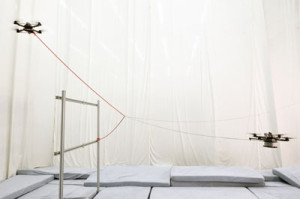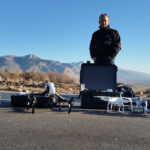By Matthew Givens
Beyond the war zone and the realm of imagination, automated drones are becoming an increasingly ubiquitous force in our daily lives. In particular, the potential applications for hovering micro air vehicles, such as quadcopters, could be transformative in many disciplines.
Among these innovations, an architecture firm in Switzerland has begun to pioneer the use of quadcopters in the field of construction. Gramazio Kohler Research (GKR), a division of Gramazio Kohler Architects based in ETH-Zürich, is using drones to autonomously build structures. Ammar Mirjan, an architect involved with the project, describes the potential of drone technology as “widening the spectrum of what is possible” within architecture and the construction environment.
Two thought experiments became reality within their research: drones autonomously assembling structures out of blocks and using cables. The first was demonstrated in style at FRAC Centre, a large public art museum in Orléans, and showcased multiple drones working together autonomously to build a large structure out of polystyrene bricks. The six-meter tower was built out of 1,500 bricks place by four quadcopters, each taking turns at charging stations and building at a rate of about 100 bricks per hour. The bricks had glue on their lower surfaces and the structure has become a permanent exhibit at the FRAC Centre.
The second thought experiment involved attaching spools of cable to drones and programming them to weave complex structures. Mirjan explains “We can fly through and around existing objects, which a person couldn’t do or a crane couldn’t do.” On top of that, the drones may be able to do these tasks faster and more efficiently than traditional methods.
While neither of these tasks demonstrated by the drones are necessarily infeasible to accomplish by other means, they do demonstrate the potential for implementation of this technology to construction applications. Currently, the drones are limited by payload capacity and accuracy concerns. As the drone technology matures, more innovative uses will emerge. Mirjan gives his perspective as an architect: “They are an interesting tool in design exploration. I don’t see them necessarily as something that competes with existing methods; it’s more widening the spectrum of what is possible.” Eventually, with the technology developed and in-hand, architects and designers will be given more freedom in their work.
Another important aspect that can be addressed with drones in the construction environment is the concept of human-drone interaction. Interacting with robots has mostly been explored by groups working with humanoid robots, but the benefits of the idea applied to flying drones are obvious. Quadcopters can be dangerous and in their current state and, due to their unsteady and dynamic state, don’t respond well to physical force inputs or commands.
Raffaello D’Andrea is a leading innovator in the quadrotor industry and works on the technical side of GKR projects, and his team is working on ways of adjusting flight models in quadcopters to respond to outside inputs. He calls it “adjusting the laws of physics” by changing mathematical models governing how the drone responds to external force inputs. Using this new programming, the ease-of-use of these drones is greatly increased and more possible applications for construction emerge.
D’Andrea is also exploring the use of visual sensing technology, like the Microsoft Kinect, to relay intuitive kinesthetic commands to drones. This could also be very useful in a construction environment.
The GKR research projects were both conducted in controlled, indoor environments. This is unlike the outdoor work environment that is associated with construction. “We are currently working in the lab, but I think something that would be interesting to do in the near future is to build a structure outside,” says Mirjan, “For example, to build a temporary structure over a canyon or a river.”
There are severe technical challenges associated with bringing drones into commercial use in outdoor construction, however. The control systems used in the GKR projects are based on Vicon infrared sensors mounted on the ceiling of the room. These sensors inform a motion capture system that orients the robots in 3D space. The drones can be programmed to do their tasks from there and to avoid other drones. This system is infeasible outside, where the Sun emits too much infrared light for the sensors to work properly. An alternative system for orientation and obstacle detection must therefore be contrived. Another problem is that the air is much less predictable and more turbulent outdoors, leading to potential hazards for people if the drones were to lose control.
The potential for drone use in construction has only barely been tapped. The technology isn’t quite to the point where it can be actively used to aid commercial construction projects, but it shows promise. As payload capacity, efficiency, battery life, control models, and sensing technology advances, innovative uses for drones will emerge. Eventually, it will give designers new tools in realizing their dreams by opening new possibilities.



